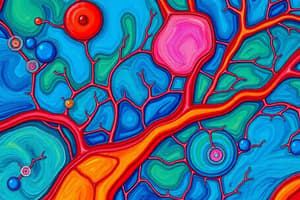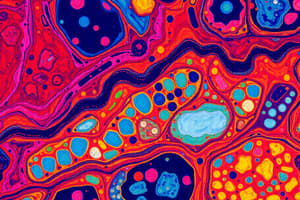Podcast
Questions and Answers
In cases where tissue regeneration is limited or impossible, which of the following processes is most likely to occur, and what is its primary characteristic?
In cases where tissue regeneration is limited or impossible, which of the following processes is most likely to occur, and what is its primary characteristic?
- Hyperplasia, leading to an increased number of cells and complete tissue restoration.
- Resolution, characterized by the complete restoration of tissue structure and function without any residual effects.
- Scar formation, marked by excessive collagen deposition and fibrosis. (correct)
- Metaplasia, where tissue converts to another type, fully restoring original function.
Which cellular event is most crucial for the transition from granulation tissue to a mature scar during tissue remodeling, and how does it alter the tissue's mechanical properties?
Which cellular event is most crucial for the transition from granulation tissue to a mature scar during tissue remodeling, and how does it alter the tissue's mechanical properties?
- Reduction in proteoglycan content, leading to decreased hydration and increased cellular density.
- Proliferation of myofibroblasts, which increases the contractile force within the tissue.
- Conversion of collagen type III to collagen type I, increasing the tissue's tensile strength. (correct)
- Increased deposition of elastin, enhancing the tissue's elasticity and restoring its original flexibility.
What key role does Transforming Growth Factor-beta (TGF-β) play in tissue repair, and how does it influence the balance between matrix synthesis and degradation?
What key role does Transforming Growth Factor-beta (TGF-β) play in tissue repair, and how does it influence the balance between matrix synthesis and degradation?
- It primarily promotes the breakdown of collagen by activating metalloproteinases, preventing excessive fibrosis.
- It enhances angiogenesis by promoting endothelial cell proliferation and blood vessel maturation.
- It stimulates fibroblast migration and proliferation while simultaneously increasing collagen synthesis and blocking the action of metalloproteinases. (correct)
- It inhibits fibroblast activity and reduces collagen production, leading to resolution rather than repair.
How does angiogenesis contribute to the regeneration phase of tissue repair, and what mechanisms control its termination as the tissue matures?
How does angiogenesis contribute to the regeneration phase of tissue repair, and what mechanisms control its termination as the tissue matures?
What are the distinct roles of neutrophils and macrophages in the early stages of tissue injury, and how do their functions coordinate with each other?
What are the distinct roles of neutrophils and macrophages in the early stages of tissue injury, and how do their functions coordinate with each other?
How do myofibroblasts contribute to wound healing, and what mechanisms regulate their activity during the remodeling phase?
How do myofibroblasts contribute to wound healing, and what mechanisms regulate their activity during the remodeling phase?
In what specific ways do fibroblasts facilitate tissue repair, and how do their actions differ based on the type of collagen they produce?
In what specific ways do fibroblasts facilitate tissue repair, and how do their actions differ based on the type of collagen they produce?
When comparing tissue repair and tissue regeneration, what are the fundamental differences between the two processes in terms of structural and functional outcomes?
When comparing tissue repair and tissue regeneration, what are the fundamental differences between the two processes in terms of structural and functional outcomes?
What role do stem cells play during the regeneration phase of tissue repair, and how does their differentiation contribute to restoring tissue function?
What role do stem cells play during the regeneration phase of tissue repair, and how does their differentiation contribute to restoring tissue function?
Considering the phases of tissue regeneration and repair, how do growth factors and cytokines secreted by inflammatory cells influence the transition from inflammation to proliferation?
Considering the phases of tissue regeneration and repair, how do growth factors and cytokines secreted by inflammatory cells influence the transition from inflammation to proliferation?
Flashcards
Repair
Repair
The process where damaged tissue is replaced or restored.
Healing
Healing
The process through which damaged tissue returns to its normal structure and function, often through repair mechanisms.
Resolution
Resolution
The restoration of normal tissue without fibrosis.
Regeneration
Regeneration
Signup and view all the flashcards
Angiogenesis
Angiogenesis
Signup and view all the flashcards
Fibroblasts
Fibroblasts
Signup and view all the flashcards
Elastin
Elastin
Signup and view all the flashcards
Collagen Type I
Collagen Type I
Signup and view all the flashcards
Collagen Type III
Collagen Type III
Signup and view all the flashcards
TGF-beta
TGF-beta
Signup and view all the flashcards
Study Notes
- Tissue regeneration and repair are key topics in pathology.
- The aim is to understand these processes in damaged tissues and the roles of connective tissue, inflammatory cells, and angiogenesis.
Terminology
- Repair, healing, and resolution are often used interchangeably.
- Repair encompasses the processes of healing and resolution, where damaged tissue is replaced or restored.
- Healing is the return of damaged tissue to its normal structure and function through repair mechanisms.
- Resolution is the restoration of normal tissue without fibrosis.
- Regeneration occurs in cells with high proliferative capacity, such as those in the skin, intestines, and liver, allowing tissue to return to its original state without scarring.
Key Components of Connective Tissue
- Blood vessels contribute to angiogenesis, forming new vessels.
- Angiogenesis provides oxygen and nutrients to support tissue repair.
- Fibroblasts are the primary cells synthesizing the extracellular matrix (ECM), producing collagen, elastin, and proteoglycans
- Fibroblasts migrate to the injury site and synthesize the ECM - important for wound healing.
- Collagen provides structural integrity to tissues.
- Type I collagen is found in mature tissues like skin and tendons, providing high tensile strength.
- Type III collagen is present in early healing stages and granulation tissue, later replaced by Type I collagen.
- Elastin gives tissues elasticity, allowing them to return to their original shape after stretching.
- Proteoglycans help retain water in the ECM, important for tissue hydration
- Myofibroblasts have contractile properties, aiding wound closure by pulling wound edges together.
- Myofibroblasts facilitate wound closure through contraction, reducing wound size and promoting faster healing.
Phases of Tissue Regeneration and Repair
- Tissue Injury, such as a paper cut, initiates the process.
- Coagulation occurs first to stop bleeding.
- Platelets form a clot to plug the defect and prevent blood loss.
- Coagulation involves clotting factors and fibrin strands.
- Inflammatory cells like neutrophils and macrophages are recruited.
- Neutrophils combat infection by phagocytosing bacteria and debris.
- Macrophages clear dead tissue and release cytokines and growth factors to coordinate healing.
- The Regeneration Phase starts after 1-2 days and lasts for weeks.
- Stem cell proliferation and differentiation occur, producing specific cells needed for tissue restoration.
- Granulation tissue forms as a scaffold for regeneration, rich in fibroblasts, blood vessels, and ECM.
- Angiogenesis forms new blood vessels for tissue supply and waste removal.
- Epithelial cells proliferate and migrate across the wound, restoring the skin barrier.
- The Remodeling Phase starts at 1 month and beyond.
- Type III collagen is replaced by stronger Type I collagen, increasing tissue tensile strength.
- Excessive Type I collagen deposition leads to scar formation (fibrosis) if regeneration is incomplete.
- The end product is either fully regenerated tissue (no scar) or a scar.
- Remodeling leads to tissue maturation and collagen fiber reorganization to provide better structural support.
Timeframe and Progression
- At 1 day: tissue injury leads to blood clot formation and inflammation.
- The initial goal is to stop bleeding and start repair.
- At 1 week: inflammatory cells have cleared, and tissue regeneration is underway.
- Stem cells and fibroblasts proliferate, and granulation tissue forms.
- At 1 month: remodeling begins, and new tissue becomes stronger and more organized.
- Collagen conversion from Type III to Type I strengthens the tissue, and epithelial regeneration continues.
Tissue Regeneration and Repair Key Players
- Cell Migration and Proliferation: Fibroblasts migrate to the injury site, proliferate, and produce the ECM.
- Growth Factors and Cytokines orchestrate proliferation.
- Platelet-Derived Growth Factor (PDGF) is released by platelets and macrophages, promoting fibroblast proliferation and collagen production.
- Fibroblast Growth Factor (FGF) is secreted by macrophages and endothelial cells to stimulate fibroblast activity and tissue growth.
- Transforming Growth Factor Beta (TGF-beta) drives fibroblast migration and proliferation, promoting collagen and fibronectin synthesis.
- Transforming Growth Factor Beta (TGF-beta) inhibits metalloproteinases.
- Angiogenesis occurs through:
- Fibroblast Growth Factor (FGF) recruits pericytes and smooth muscle cells to stabilize new vessels.
- Endothelial proliferation decreases as new vessels mature and stabilize.
- Basal lamina deposition completes vascular development.
Summary of Regeneration and Repair Process
- Inflammation is the initial response with coagulation and recruitment of inflammatory cells.
- Regeneration: Growth factors and cytokines stimulate fibroblast migration and ECM production.
- Remodeling: Type III collagen is replaced by Type I collagen, strengthening tissue structure.
- Organization and function improve over time.
- The End Product depends on the tissue's regenerative ability.
- One possible result is full regeneration (no scar).
- Another possible result is scar formation due to fibrosis.
End Product Scenarios
- Regeneration, such as a paper cut on the skin, can result in full skin regeneration without a visible scar.
- Scar Formation occurs if the tissue cannot regenerate due to deeper injury or inadequate stem cell function.
Studying That Suits You
Use AI to generate personalized quizzes and flashcards to suit your learning preferences.




